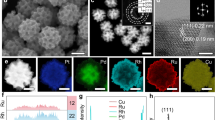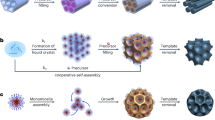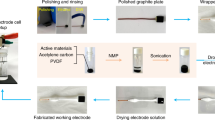Abstract
Microporous materials have found extensive application as catalysts, ion-exchange media and sorbents1,2. The discovery of mesoporous silica3 has opened the path to selective catalysis and separation of large molecules and to the synthesis of inorganic–organic composite materials, polymer mesofibres and semiconducting quantum dots4,5,6,7. Various oxide-based mesoporous materials, such as TiO2, ZrO2, SnO2, Al2O3, Nb2O5 and GeO2, have been reported8,9,10,11,12,13. A challenge for materials research is now to expand the scope of mesoporous materials beyond the oxides. Only a few non-oxide mesostructured composites, such as CdS, SnS2 and CdSe, have been reported; they are usually synthesized by ad hoc hydrothermal methods or from aqueous solutions containing ill-defined species, and are often not well characterized14,15,16. Herewe report the rational synthesis of a new family of metal germanium sulphide mesostructured materials prepared by a non-aqueous surfactant-templated assembly of adamantanoid [Ge4S10]4− cluster precursors. In the presence of quaternary alkylammonium surfactants, [Ge4S10]4− anions in formamide solution self-organize with metal cations (Co2+, Ni2+, Cu+ and Zn2+) to create well ordered hexagonal metal germanium sulphide mesostructures, some having fibre-like morphologies with channels running down the long axis of the fibre. Materials of this genre could prove effective in applications as diverse as detoxification of heavy metals in polluted water streams, sensing of sulphurous vapours, and the formation of semiconductor quantum ‘anti-dot’ devices.
This is a preview of subscription content, access via your institution
Access options
Subscribe to this journal
Receive 51 print issues and online access
$199.00 per year
only $3.90 per issue
Buy this article
- Purchase on Springer Link
- Instant access to full article PDF
Prices may be subject to local taxes which are calculated during checkout




Similar content being viewed by others
References
Szostak, R. Handbook of Molecular Sieves (Van Nostrand Reinhold, New York, 1992).
Breck, D. W. Zeolite Molecular Sieves: Structure, Chemistry, and Use (Wiley-Interscience, Toronto, 1974).
Kresge, C. T., Leonowicz, M., Roth, W. J., Vartuli, J. C. & Beck, J. C. Ordered mesoporous molecular sieves synthesized by a liquid-crystal template mechanism. Nature 359, 710–712 (1992).
Sellinger, A. et al. Continuous self-assembly of organic–inorganic nanocomposite coatings that mimic nacre. Nature 394, 256–260 (1998).
Wu, C. & Bein, T. Conducting polyaniline filaments in a mesoporous channel host. Science 264, 1757–1759 (1994).
Maschmeyer, T., Rey, F., Sankar, G. & Thomas, J. M. Heterogeneous catalysts obtained by grafting metallocene complexes onto mesoporous silica. Nature 378, 159–162 (1995).
Chomski, E., Dag, & & Ouml;., & Kuperman, A., Coombs, N. & Ozin, G. A. New forms of luminescent silicon:silicon-silica composite mesostructures. Chem. Vap. Deposition 2, 8–13 (1996).
Hue, Q. S. et al. Generalized synthesis of periodic surfactant/inorganic composite materials. Nature 368, 317–321 (1994).
Antonelli, D. M. & Ying, J. Y. Synthesis of a stable hexagonally packed mesoporous niobium oxide molecular sieve through a novel ligand-assisted templating mechanism. Angew. Chem. Int. Edn. Engl. 35, 426–430 (1996).
Bagshaw, S. A. & Pinnavaia, T. J. Mesoporous alumina molecular sieves. Angew. Chem. Int. Edn. Engl. 35, 1102–1105 (1996).
Tian, Z.-R. et al. Manganese oxide mesoporous structures: mixed-valent semiconducting catalysts. Science 276, 926–930 (1997).
Ciesla, U., Schacht, S., Stucky, G. D., Unger, K. K. & Scüth, F. Formation of a porous zirconium oxo phosphate with a high surface area by a surfactant-assisted synthesis. Angew. Chem. Int. Edn. Engl. 35, 541–543 (1996).
Yang, P., Zhao, D., Margolese, D. I., Chmelka, B. F. & Stucky, G. D. Generalized syntheses of large-pore mesoporous metal oxides with semicrystalline frameworks. Nature 396, 152–155 (1998).
Braun, P. V., Osenar, P. & Stupp, S. I. Semiconducting superlattices templated by molecular assemblies. Nature 380, 325–328 (1996).
Fröba, M. & Oberender, N. First synthesis of mesostructured thiogermanates. Chem. Commun. 1729–1730 (1997).
Neeraj & Rao, C. N. R. Metal chalcogenide-organic nanostructured composites from self-assembled organic amine templates. J. Mater. Chem. 8, 279–280 (1998).
Bedard, R. L., Vail, L. D., Wilson, S. T. & Flanigen, E. M. Hydrocarbon conversion process using crystalline microporous metal sulfide compositions. US Patent 4,933,068 (1990).
Bedard, R. L., Wilson, S. T., Vail, L. D., Bennett, J. M. & Flanigen, E. M. in Zeolites: Facts, Figures, Future (eds Jacobs, P. A. & van Santen, R. A.) 375–387 (Elsevier, Amsterdam, 1989).
Yaghi, O. M., Sun, Z., Richardson, D. A. & Groy, T. L. Directed transformation of molecules to solids: synthesis of a microporous sulfide from molecular germanium sulfide cages. J. Am. Chem. Soc. 116, 807–808 (1994).
Tan, K., Darovsky, A. & Parise, J. B. Synthesis of a novel open-framework sulfide, CuGe2S5·(C2H5)4N, and its structure solution using synchrotron imaging plate data. J. Am. Chem. Soc. 117, 7039–7040 (1995).
Sheldrick, W. S. & Wachhold, M. Solventothermal synthesis of solid-state chalcogenidometalates. Angew. Chem. Int. Edn. Eng. 36, 206–224 (1997).
Achak, O., Pivan, J. Y., Maunaye, M., Loüer, M. & Loüer, D. Structure refinement by the Rietveld method of the thiogermanates [(CH3)4N]2MGe4S10(M = Fe, Cd). J. Solid State Chem. 121, 473–478 (1996).
Bowes, C. L. et al. Thermally stable self-assembling open-frameworks: isostructural Cs+ and (CH3)4N+ iron germanium sulfides. Chem. Ber. 129, 283–287 (1996).
Wärnheim, T. & Jönsson, A. Phase diagrams of alkyltrimethylammonium surfactants in some polar solvents. J. Colloid Interface Sci. 125, 627–633 (1988).
Bonhomme, F. & Kanatzidis, M. G. Structurally characterized mesostructured hybrid surfactant-inorganic lamellar phases containing the adamantane [Ge4S10]4 anion: synthesis and properties. Chem. Mater. 10, 1153–1159 (1998).
Bowes, C. L. et al. Dimetal linked open frameworks: [(CH3)4N]2(Ag2,Cu2)Ge2S10. Chem. Mater. 8, 2147–2152 (1996).
Acknowledgements
We thank R. L. Bedard for helpful discussions, critical reading of the manuscript and elemental analyses of the materials. We thank E. Chomski for creative and technical assistance with Fig. 4. G.A.O. acknowledges the Killam Foundation for the award of an Isaac Walton Killam research fellowship (1995–97). M.J.M. is indebted to NSERC for a post-graduate scholarship (1995–99). This work was supported by the Natural Sciences and Engineering Research Council of Canada (NSERC) and UOP.
Author information
Authors and Affiliations
Corresponding author
Rights and permissions
About this article
Cite this article
MacLachlan, M., Coombs, N. & Ozin, G. Non-aqueous supramolecular assembly of mesostructured metal germanium sulphides from (Ge4S10)4− clusters. Nature 397, 681–684 (1999). https://doi.org/10.1038/17776
Received:
Accepted:
Issue Date:
DOI: https://doi.org/10.1038/17776
This article is cited by
-
Electrochemical synthesis of mesoporous gold films toward mesospace-stimulated optical properties
Nature Communications (2015)
-
Mesoporous Co3O4 as an electrocatalyst for water oxidation
Nano Research (2013)
-
The Role of Energy in the Emergence of Biology from Chemistry
Origins of Life and Evolution of Biospheres (2012)
-
Selective incarceration of caesium ions by Venus flytrap action of a flexible framework sulfide
Nature Chemistry (2010)
-
Mesolamellar phases containing [Fe(CN)6]3− anion
Journal of Materials Science (2010)
Comments
By submitting a comment you agree to abide by our Terms and Community Guidelines. If you find something abusive or that does not comply with our terms or guidelines please flag it as inappropriate.



